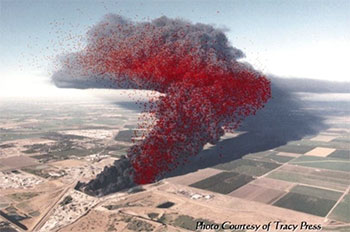The center originated out of a 1973 Department of Energy (DOE) concept for an Atmospheric Release Advisory Capability (ARAC) that could merge "wind prediction models, atmospheric transport and diffusion models, current weather data bases, and the data bases regarding dose response of humans to multiple nuclide exposures ... into an integrated system". A prototype ARAC system was under development on March 28, 1979 when the Three Mile Island nuclear power plant accident began. The next day, LLNL received a telephone call from DOE headquarters asking, "Could ARAC help and how soon?" The center became operational in April and worked around-the-clock on the accident for a 2-week period, its first emergency response. (By Joe Knox, 2002)
Although originally developed for radiological/nuclear releases in the United States, chemical and biological capabilities were added to the system starting in the 1980s and expanded under the DOE Chemical and Biological National Security Program in the 1990s-2000s. Global geographic databases were incorporated to provide worldwide modeling capabilities. In 1996, a new dedicated facility—the National Atmospheric Release Advisory Center (NARAC)—was constructed at LLNL by DOE to house the center and its staff.
In order to provide easy access to its modeling products, NARAC developed Web-based remote access software that has become the primary means of sharing plume analyses and related event information with users and agencies involved in a response. Multiple NARAC Web sites have been created to support different user communities. The Web-based software also allows authorized users to run fully-automated NARAC modeling simulations.
Since its creation, NARAC has responded to numerous events including nuclear power plant, nuclear material processing, and nuclear weapons accidents, nuclear weapons tests, NASA planetary mission launches involving radioactive materials, toxic industrial chemical spills and fires, biological agent detections, and natural disasters such as volcanic eruptions. The center regularly engages in exercises and drills to ensure readiness in case of a real-world event and to develop collaborative relationships with other agencies that may be involved in a response. In addition, NARAC conducts modeling studies that support emergency response preparedness, risk assessments, consequence management, forensics, and recovery.
The History of the National Atmospheric Release Advisory Center
For more than 40 years, the NARAC has been the premiere resource for near-real-time computer predictions of the spread of hazardous airborne materials. Decision-makers and emergency managers around the globe use this predictive capability to protect lives, mitigate consequences and inform responders.





